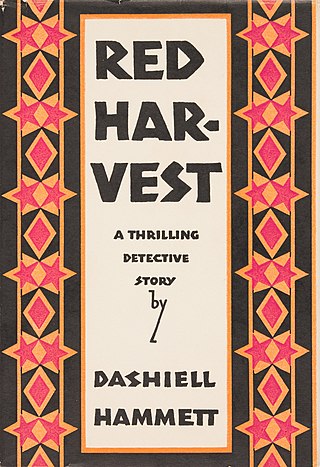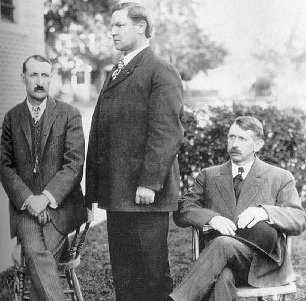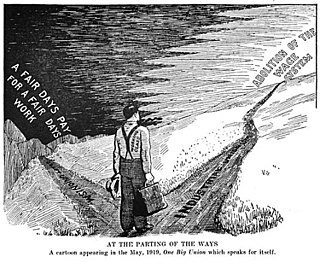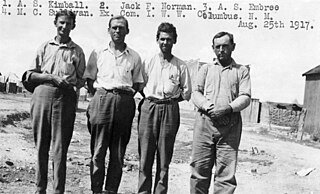Related Research Articles

The Industrial Workers of the World (IWW), whose members are nicknamed "Wobblies", is an international labor union founded in Chicago in 1905. The nickname's origin is uncertain. Its ideology combines general unionism with industrial unionism, as it is a general union, subdivided between the various industries which employ its members. The philosophy and tactics of the IWW are described as "revolutionary industrial unionism", with ties to socialist, syndicalist, and anarchist labor movements.

Red Harvest (1929) is a novel by American writer Dashiell Hammett. The story is narrated by the Continental Op, a frequent character in Hammett's fiction, much of which is drawn from his own experiences as an operative of the Pinkerton Detective Agency. The plot follows the Op's investigation of several murders amid a labor dispute in a corrupt Montana mining town. Some of the novel was inspired by the Anaconda Road massacre, a 1920 labor dispute in the mining town of Butte, Montana.

Butte is a consolidated city-county and the county seat of Silver Bow County, Montana, United States. In 1977, the city and county governments consolidated to form the sole entity of Butte-Silver Bow. The city covers 718 square miles (1,860 km2), and, according to the 2020 census, has a population of 34,494, making it Montana's fifth-largest city. It is served by Bert Mooney Airport with airport code BTM.

The Western Federation of Miners (WFM) was a labor union that gained a reputation for militancy in the mines of the western United States and British Columbia. Its efforts to organize both hard rock miners and smelter workers brought it into sharp conflicts – and often pitched battles – with both employers and governmental authorities. One of the most dramatic of these struggles occurred in the Cripple Creek district of Colorado in 1903–1904; the conflicts were thus dubbed the Colorado Labor Wars. The WFM also played a key role in the founding of the Industrial Workers of the World in 1905 but left that organization several years later.

Franklin Henry Little, commonly known as Frank Little, was an American labor leader who was murdered in Butte, Montana. No one was apprehended or prosecuted for Little's murder. He joined the Industrial Workers of the World in 1905, organizing miners, lumberjacks, and oil field workers. He was a member of the union's Executive Board when he was murdered and lynched.
The following is a timeline of labor history, organizing & conflicts, from the early 1600s to present.

Charles H. Moyer was an American labor leader and president of the Western Federation of Miners (WFM) from 1902 to 1926. He led the union through the Colorado Labor Wars, was accused of murdering an ex-governor of the state of Idaho, and was shot in the back during a bitter copper mine strike. He also was a leading force in founding the Industrial Workers of the World, although he later denounced the organization.
The Anaconda Copper Mining Company, known as the Amalgamated Copper Company from 1899 to 1915, was an American mining company headquartered in Butte, Montana. It was one of the largest trusts of the early 20th century and one of the largest mining companies in the world for much of the 20th century.
The 1983 Arizona copper mine strike began as a labour dispute between the Phelps Dodge Corporation and a group of union copper miners and mill workers, led by the United Steelworkers. The subsequent strike lasted nearly three years and resulted in the replacement of most of the striking workers and decertification of the unions. It is regarded as an important event in the history of the United States labor movement.

The Industrial Workers of the World (IWW) is a union of wage workers which was formed in Chicago in 1905 by militant unionists and their supporters due to anger over the conservatism, philosophy, and craft-based structure of the American Federation of Labor (AFL). Throughout the early part of the 20th century, the philosophy and tactics of the IWW were frequently in direct conflict with those of the AFL concerning the best ways to organize workers, and how to best improve the society in which they toiled. The AFL had one guiding principle—"pure and simple trade unionism", often summarized with the slogan "a fair day's pay for a fair day's work." The IWW embraced two guiding principles, fighting like the AFL for better wages, hours, and conditions, but also promoting an eventual, permanent solution to the problems of strikes, injunctions, bull pens, and union scabbing.

The Granite Mountain/Speculator Mine disaster of June 8, 1917, occurred as a result of a fire in a copper mine, and was the most deadly event in underground hard rock mining in United States history. Most men died of suffocation underground as the fire consumed their oxygen; a total of 168 miners were killed. The Butte, Montana copper mines were at full wartime production to support the US in World War I. Miners had been seeking improved working conditions, as they were at high risk.

The Butte–Anaconda Historic District is a National Historic Landmark (NHL) that spans parts of Walkerville, Butte and Anaconda, Montana, United States. It has the most resources of any U.S. National Historic Landmark District.
The Copper Country strike of 1913–1914 was a major strike affecting all copper mines in the Copper Country of Michigan. The strike, organized by the Western Federation of Miners, was the first unionized strike within the Copper Country. It was called to achieve goals of shorter work days, higher wages, union recognition, and to maintain family mining groups. The strike lasted just over nine months, including the Italian Hall disaster on Christmas Eve, and ended with the union being effectively driven out of the Keweenaw Peninsula. While unsuccessful, the strike is considered a turning point in the history of the Copper Country.

Anti-union violence is physical force intended to harm union officials, union organizers, union members, union sympathizers, or their families. It is most commonly used either during union organizing efforts, or during strikes. The aim most often is to prevent a union from forming, to destroy an existing union, or to reduce the effectiveness of a union or a particular strike action. If strikers prevent people or goods to enter or leave a workplace, violence may be used to allow people and goods to pass the picket line.
The Boston and Montana Consolidated Copper and Silver Mining Company was a mining, smelting, and refining company which operated primarily in the state of Montana in the United States. It was established in 1887 and merged with the Amalgamated Copper Company in 1901. The Amalgamated Copper Company changed its name to Anaconda Copper in 1910, and became one of America's largest corporations. Historian Michael P. Malone has written, "Well financed and well managed, the Boston and Montana came to rank among the world's greatest copper companies."

A. S. Embree was an American union organizer, Christian minister, and, leader in the Industrial Workers of the World (IWW). Embree served as the secretary-treasurer pro-tem of the national IWW for a period of two months after the national office was raided by federal agents.

Anti-union violence in the United States is physical force intended to harm union officials, union organizers, union members, union sympathizers, or their families. It has most commonly been used either during union organizing efforts, or during strikes. The aim most often is to prevent a union from forming, to destroy an existing union, or to reduce the effectiveness of a union or a particular strike action. If strikers prevent people or goods to enter or leave a workplace, violence may be used to allow people and goods to pass the picket line.

The Butte, Montana labor riots of 1914 were a series of violent clashes between copper miners at Butte, Montana. The opposing factions were the miners dissatisfied with the Western Federation of Miners local at Butte, on the one hand, and those loyal to the union local on the other. The dissident miners formed a new union, and demanded that all miners must join the new union, or be subject to beatings or forced expulsion from the area. Sources disagree whether the dissidents were a majority of the miners, or a militant minority. The leadership of the new union contained many who were members of the Industrial Workers of the World (I.W.W.), or agreed with the I.W.W.'s methods and objectives. The result of the dispute between rival unions was that the copper mines of Butte, which had long been a union stronghold for the WFM, became open shop employers, and recognized no union from 1914 until 1934.

Butte is a city in southwestern Montana established as a mining camp in the 1860s in the northern Rocky Mountains straddling the Continental Divide. Butte became a hotbed for silver and gold mining in its early stages, and grew exponentially upon the advent of electricity in the late-nineteenth century due to the land's large natural stores of copper. In 1888 alone, mining operations in Butte had generated an output of $23 million. The arrival of several magnates in the area around this time, later known as the "Copper Kings," marked the beginning of Butte's establishment as a boomtown.
The Goldfield, Nevada labor troubles of 1906–1907 were a series of strikes and a lockout which pitted gold miners and other laborers, represented by the Western Federation of Miners (WFM) and the Industrial Workers of the World (IWW), against mine owners and businessmen.
References
- 1 2 3 4 5 Murphy, Mary (1997). Mining Cultures . University of Illinois Press. pp. 33. ISBN 978-0-252-06569-9.
- 1 2 Malone, Michael P.; Roeder, Richard B.; Lang, William L. (1991). Montana: A History of Two Centuries. University of Washington Press. p. 328. ISBN 978-0-295-97129-2.
- 1 2 3 4 5 Walter, David (2002). More Montana Campfire Tales. Farcountry Press. pp. 211–224. ISBN 978-1-56037-236-3.
- ↑ Goldstein, Robert Justin (2001). Political Repression in Modern America . University of Illinois Press. ISBN 978-0-252-06964-2.
- ↑ Panek, LeRoy Lad (2004). Reading Early Hammett: A Critical Study of the Fiction Prior to 'The Maltese Falcon' . MacFarland & Company. pp. 122.
- ↑ Hammett, Dashiell (October 1965). The Novels of Dashiell Hammet. New York: Alfred A. Knopf. p. 7.
- ↑ Hammet (1965), p 101.
